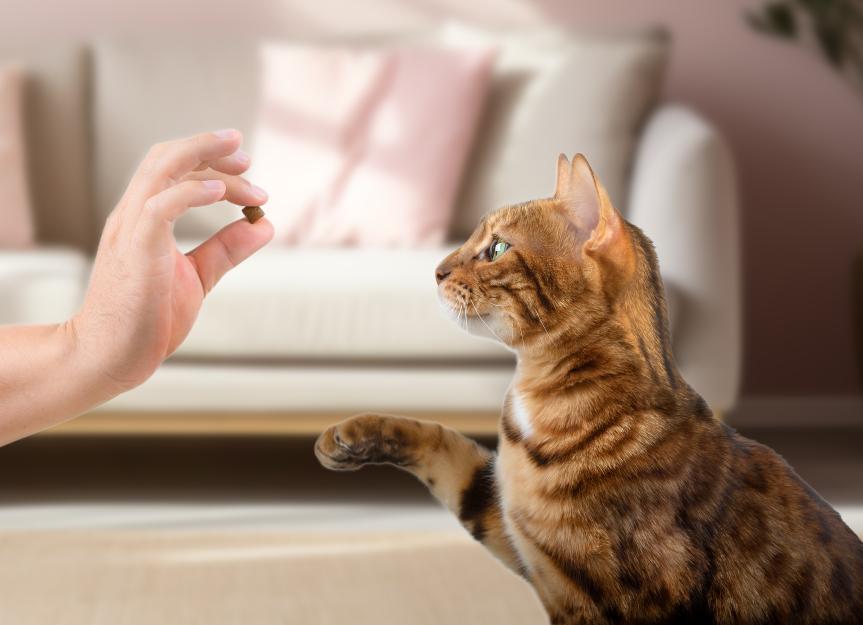
What to Consider When Choosing Cat Treats
Purpose
Our panel of experts recommends matching the cat treat to the purpose. For example, training treats should be small, attractive, easy to eat quickly and low in calories since they are given more than a few during training. cat training sessions.
Look for research-backed brands and key ingredients, especially when choosing a treat to help control hairballs or support dental or joint health.
Our specialists particularly value dental treatments with Veterinary Oral Health Council (VOHC), which certifies that they have been scientifically proven to control plaque and/or tartar when used as directed.
Texture
Cat treats come in a variety of textures: pureed, soft, chewy and crunchy. Match the texture of the treat to your cat’s preference, age and health.
Our panel of pet health experts recommend introducing kittens to a variety of textures early on to avoid pickiness later in life.
Flavor
Look for the flavor your cat likes best, especially for training treats. Since cats are obligate carnivores, meaning they need meat to survive, most cat treats come in meat flavors, which cats typically love.
Our expert panel recommends introducing a variety of flavors, especially for kittens, to prevent them from overeating later in life. However, it’s important to change treat flavors slowly and carefully to avoid upset stomach and give your cat time to adjust to the new flavors and textures.
Calories
The number 1 criteria for all our veterinary experts when choosing treats is that they are low in calories. Sixty-one percent of pet cats are overweight or obeseand monitoring treatment calories is essential for controlling weight.
If your cat is overweight, consider a treat with about 2 calories or less per treat and be sure to give no more than 10% of the total calories allocated as treats per day.
Health benefit
If your cat has a specific health problem – anxiety, dental problems, hairballs – work with your veterinarian to find a treat formulated to address the problem.
Choose a trusted brand that conducts scientific research to prove the treat’s effectiveness.
Before introducing a new treat, especially if your cat has an illness like diabetes or food sensitivities, check with your veterinarian. Not all treats meet the dietary needs of cats with special health problems.
How We Selected the Best Cat Treats
This list of the best cat treats was meticulously selected by a panel of veterinarians and veterinary technicians who work at Chewy, publisher of PetMD.
They were asked to choose the best cat treats in their honest opinion, across several categories, based on the following:
- Your knowledge and practical experience
- A review of information published by manufacturers
- Attributes such as purpose, texture, flavor, calories and health benefits
The opinions and product recommendations in this article belong solely to the review panel of veterinarians and animal health experts. Manufacturers and suppliers cannot purchase placement in Vet Verified content or exert influence over our panelists while reviewing products.
Our only goal with this program is to provide pet parents with the information they need to make the best decision for their pets.
Cat Treats FAQ
Q: What are healthy treats for a cat?
ONE: Healthy cat treats meet your pet’s individual needs and are low in calories. Choose treats from a trusted brand that are appropriate for your cat’s age and contain no artificial colors or flavors.
If your cat has a specific health problem, such as anxiety, hairballs or dental problems, look for beneficial ingredients that address the problem. Your veterinarian can help you make the best choice for your cat’s individual needs.
Q: What’s an irresistible treat for cats?
ONE: Cats love tasty, aromatic (i.e. deliciously smelly!) treats made with their favorite proteins like fish or chicken. Match the texture of the treat to your cat’s preference – crunchy treats for those who like dry food and soft or pureed treats for seniors or cats with dental problems.
Q: Should cats have treats every day?
ONE: Giving cats treats every day can support bonding and training. Treats should be low in calories and factored into your cat’s daily calorie intake. Adjust your cat’s meal portions according to the calories in the treat, making sure the treats never make up more than 10% of the total diet.
Q: What are the best cat treats for training?
ONE: The best training treats are high-value, low-calorie treats designed to quickly capture your cat’s attention.
High-value cat treats are those that have the flavor and texture your cat loves and comes running for. They should be small and soft or chewable, making them convenient to give quickly and easily swallowed.





